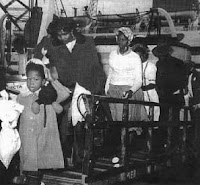 The Second World War had left the United Kingdom with a labour shortage, just when it needed as many workers as possible for the task of reconstruction. To alleviate this shortage the Royal Mail Lines placed an advertisement in the Jamaica’s Daily Gleaner newspaper in April 1948. The advertisement offered a ticket Kingston, Jamaica to England for only £28 and 10 shillings on the ex-German troopship Empire Windrush, which was due to dock in the Caribbean on its journey from Australia back to the Britain.
The Second World War had left the United Kingdom with a labour shortage, just when it needed as many workers as possible for the task of reconstruction. To alleviate this shortage the Royal Mail Lines placed an advertisement in the Jamaica’s Daily Gleaner newspaper in April 1948. The advertisement offered a ticket Kingston, Jamaica to England for only £28 and 10 shillings on the ex-German troopship Empire Windrush, which was due to dock in the Caribbean on its journey from Australia back to the Britain.
Many of the 492 people that took up this offer were ex-servicemen – mostly from the Royal Air Force – who either hoped to rejoin the RAF or wanted to take up the promise of work and a better life in their “mother country”. Many Britons were not pleased at the thought of immigrant workers, and Parliament debated the matter while the ship was crossing the ocean. Nevertheless, many of the passengers had served during the war for “King and Country” and all carried British passports, so there was no legal cause to turn them away.
On 24th May 1948, the Empire Windrush set sail on her month long journey across the Atlantic, which ended on 22nd June when she docked at Tilbury in Essex. On arrival, just under half of the West Indians received temporary accommodation at the Clapham South deep shelter in London – built as an air-raid shelter during the war beneath the underground railway station.
Over two hundred of them found work straight away, mostly in the newly instituted National Health Service and with London Transport. The nearest labour exchange (office where they could find work) was in nearby Brixton, an area where many of them found homes, bestowing upon that area its multi-racial heritage.
During the Parliamentary debates on immigration, the politicians who promoted imported labour suggested that the workers that the foreign workers would only stay for a short while, and indeed many of the West Indians thought the same. Nevertheless, many chose to stay and raise families in their new home. The journey of the Empire Windrush marked the beginning of a new – and as is often the case, troubled – era of multiculturalism in Britain.
The BBC History website has a number of pages devoted to the Empire Windrush generation, including the memories of some of the ship’s passengers.


